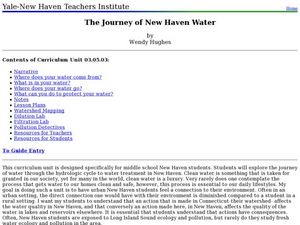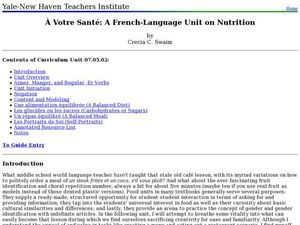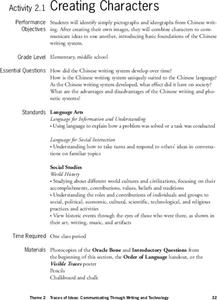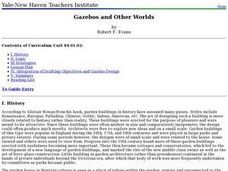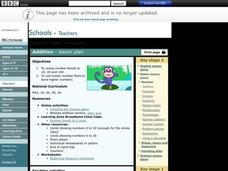Curated OER
Monitoring an Epidemic: Analyzing Through Graphical Displays Factors Relating to the Spread of HIV/AIDS
Tenth graders differentiate pandemic and epidemic. In this health science lesson plan, 10th graders analyze how HIV and AIDS affect different countries. They construct and interpret different types of graphs.
Curated OER
After the Garbage Can: Where Does Our Trash Go?
Learners explore how waste disposal has changed over time and what the current issues are. In this disposal instructional activity students collect data and create graphs.
Curated OER
The Journey of New Haven Water
Students become familiar with the water cycle and water issues. In this water lesson students examine what they can do to protect their water.
Curated OER
Music Composition
Students compose a simple melody using the notes of the D Major Scale. Criteria/Rubric for evaluation is provided with variations depending on skill level of students. A minimum of one forty-five minute class period is needed for this...
Curated OER
Starting at the Beginning
Sixth graders develop basic band skills through in-class instruction, individual practice, and the Essential Elements band method. Instruction is teacher-led with examples and drill/practice. National Standards for the arts are...
Curated OER
The Element of Color
Eighth graders study and analyze the elements of color by creating an personalized color wheel. Emphasis is placed on constructive criticism of student work by others for assessment. Students create short poems for their color wheel...
Curated OER
Water, Water Everywhere?
Students discover the relationship between water availability and population growth. They change variables in a computer model using a worksheet to guide their hypotheses and conclusions. In small groups they choose a country undergoing...
Curated OER
À Votre Sant?: A French-Language Unit on Nutrition
Students discover the basic nutritional information for different foods. For this nutrition lesson students classify items, identify what a balanced diet is and determine what recipes are healthy.
Curated OER
Streams of Time Lesson Plan: Visually Organizing the History of the Atlantic Slave Trade
Middle schoolers, after reading the Transatllantic Slave Trade, create a color coded triple-timeline to help them explain the chronological streams that flow through the essay.
Curated OER
Puerto Rico . . . Its Land, History, Culture, and Literature
Students examine Puerto Rico's location and from its geographic location, reflect on its culture and people. They also read a play by a Puerto Rican author. This is an excellent cross-curricular unit, including history, geography, and...
Curated OER
Creating Characters
Learners identify simple pictographs and ideographs from Chinese writing. They create their own images, and combine characters to communicate ideas to one another, introducing basic foundations of how elements of the Chinese writing...
Curated OER
Heroes and Heroines: King David, Julius Caesar, Cleopatra and Napoleon
Students identify and examine four heroes from history and imaginative literature. They discuss the characteristics of a hero and share perceptions of what makes a hero. By comparing and analyzing a few historical and literary figures,...
Curated OER
Gazebos and Other Worlds
Design a simple structure such as the gazebo. Work with your class to identify the six faces of a cube pattern and name other uses of patterns in industry. They draft, cut out, and assemble a cube pattern. They draw out and assemble two...
Curated OER
Writing Process-- Revision and Editing
As guided practice, class members work together to revise a model persuasive paragraph. Then they practice independently with their own writing. The included rubric looks at prewriting, drafting, revising, editing, nonfiction text...
Curated OER
Write a Story
Here is a great way to explore narrative writing! Learners review a previously constructed story map and identify the characters, setting, and main events in the book Anansi and the Moss-Covered Rock retold by Eric A. Kimmel. They...
Curated OER
Childhood in Early 19th-Century America
Learners interpret and analyze primary source documents and compare and contrast childhood today with that of the past.
Curated OER
Measure: Bearings and Scale Drawings
Young mathematicians practice measuring acurately with a protractor. They convert measurements using a scale factor, then translate the new information into diagrams. This lesson should be a hit in that it's mostly hands-on work with the...
Curated OER
Measure: Bearings and Scale Drawings
Pupils practice drawing geometric figures. In this geometry lesson, learners complete an activity that requires them to draw angles and shapes to the nearest degree.
Curated OER
Addition
Explore the concept of number bonds with your young elementary students. They will become familiar with the number bonds to 10, 20, and 100, and then play games to practice these skills. This is a differentiated lesson which includes an...
Curated OER
Number Patterns
An easy way to introduce numerical patterns, these activities can be made simpler by using addition, or more difficult with division, fractions, and percentages. Children examine patterns and determine the missing number in the sequence....
Curated OER
Immigration Debate
The 2010 immigration bill passed in Arizona provides class members with an opportunity to examine various perspectives of the immigration debate by watching news videos, reading interview, editorials, and viewing images. Discussion...
University of Washington
Pasta Genetics
Four different-shaped and dyed pasta types represent four different alleles. Following a guide sheet, young geneticists practice randomly selecting alleles and discover the traits of the resulting offspring. This is a fun and solid...
Curated OER
How to Clean Up an Oil Slick
Students explore how an oil spill is contained and cleaned up. They investigate an oil absorbing polymer that is hydrophobic, absorbs up to 19 times its own weight in nonpolar liquids, floats on water, and can be reused or disposed of by...
Curated OER
Determining Cutting Site Locations
Students explore DNA restriction mapping. They cut pieces of paper into lengths representing those produced when specific enzymes are used to cut a strand of DNA.




